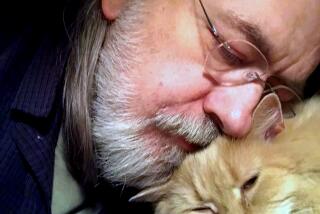Hello There, Fella--Shall We SPLAF?
- Share via
Having brought to light the phrase jamais vu-- the opposite of deja vu --my readers have also enlightened me on another phenomenon for which there seemed to be no word.
What do we call that little dance that people do when they meet on the sidewalk or any other passageway, both dodging first to the right, then to the left, and so on, until they both come finally to a standstill, and break out in embarrassed laughter.
Sometimes, at least in legend, the people get acquainted and strike up what is now called a relationship. These happy accidents used to be called cute meets, though of course a cute meet does not invariably end in marriage, children and fulfillment.
Betty Metzler, who raised the question, suggested that it be called “doing the dipsy-doodle.”
Barbara Tiffany of Palm Desert calls it the “double reverse sidestep.” Bob Stanford of North Hollywood suggests “the Hezitation Waltz.”
In the north country of England, says John Trayne, this little contretemps is called the “hesistep.”
“The fact that this remarkable word never got into the dictionary,” he explains, “is not surprising since the north country of England is, in reality, an entirely different planet from Earth where the name of their language is Gordie. . . .”
Kitty Johnson writes that “when describing the awkward double sidestep with a stranger on the street, the correct term is impas de deux .” (Shouldn’t that be impasse , meaning blind alley, cul-de-sac, dead end?)
An impasse de deux indeed it is, but Henriette Goldsmith suggests that the impasse may be ended with a simple question: “Shall we dance?”
Sticking with French, Brian Petraborg suggests en passant impasse or impasse en passant , noting that either “fits the bill perfectly.”
Radford Bivans calls it a faux pas de deux , which seems to me a very clever solution. One imagines two ballet dancers missing their cues and doing, so to speak, the dipsy-doodle. Would that not be a faux pas ?
Conway L. Gordon of La Jolla, like several others, suggests “Alphonse-Gaston,” of well-known origin.
Denckla (Dede) S. Tower suggests “entango,” which is not bad, suggesting tango and entanglement.
Kristi Kane of Sherman Oaks suggests “kinesic stuttering, kinesics being the study or science of body language, stuttering being its own definition. I personally adore the phrase because it so vividly describes the foul-up of body communication.”
Joe Martini reports that Tom Wagner, then a Berkeley undergraduate, proposed the acronym SPLAF in a letter to him and another friend, Beth Romano.
“Since your visit, I have given much thought to your attempts to find a word that means ‘when two people are walking down the street and then each goes back and forth stepping sideways trying to get out of each other’s way, but actually getting in each other’s way.’ Well, today as I was splashing through Sproul Plaza, I was hit with a sudden burst of inspiration. Now although it is admittedly not a single word, but rather a phrase, and a rather long one at that, I believe that the following captures within it all the necessary concepts contained in that certain ungraspable word mentioned above: Simultaneous Pedestrian Lateral Avoidance Failure. In short, SPLAF.”
“In the past five years,” Martini adds, “the three of us have splaffed often on our UC campuses at Berkeley, Santa Barbara and Los Angeles. In fact, Tom has even splaffed with a collie.
“For my part,” he goes on, “I find splaffing to be wonderfully therapeutic because it enables strangers in our massive city to share a spontaneous smirk, smile or giggle. For that reason, I’m glad that few pedestrians adhere to the seemingly logical convention of passing on the right like cars.”
Whether we call it the dipsy-doodle, the hesistep, the faux pas de deux or the SPLAF, this unintentional encounter will survive.
I call it unintentional because I don’t believe anyone can contrive to meet someone by deliberately staging a SPLAF. How will he know which way the other person’s going to go?
We are human beings, not automatons, and we cannot be programmed to go always to the right.
More to Read
Sign up for our Book Club newsletter
Get the latest news, events and more from the Los Angeles Times Book Club, and help us get L.A. reading and talking.
You may occasionally receive promotional content from the Los Angeles Times.







